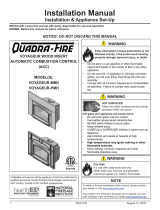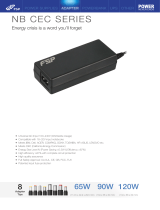
17July 30, 2019 7095-802B
EXPEDITION II INSERT
The following modications of factory-built replaces
are permissible:
• The replace must not be altered. Cutting any sheet
metal parts of the replace in which the replace insert
is to be installed is prohibited per ANSI Z21.88 except
that the damper may be removed to accommodate a
direct-connect starter pipe or chimney liner,
• External trim pieces which do not aect the operation
of the replace may be removed providing they can be
stored on or within the replace for reassembly if the
insert is removed.
• The permanent metal warning label provided in the
component pack must be attached to the back of the
replace, with screws or nails, stating that the replace
may have been altered to accommodate the insert,
and must be returned to original condition for use as a
conventional replace (Figure 17.1).
• If the hearth extension is lower than the replace
opening, the portion of the insert extending onto the
hearth must be supported.
• Manufacturer designed adjustable support kit can be
ordered from your dealer.
• Final approval of this installation type is contingent
upon the authority having jurisdiction.
M. Altering the Fireplace
L. Ovalizing Round Stainless Steel Liners
Ovalizing round stainless steel liners to accommodate the
liner passing through the damper region of a replace is an
allowable and acceptable practice.
Ensure that the ovalization is minimized to the extent
required to t through the damper.
The following parts may be removed:
Damper Smoke Shelf or Bae
Ember Catches Fire Grate
Viewing Screen/Curtain Doors
250-2061
THIS FIREPLACE MAY HAVE BEEN ALTERED
TO ACCOMMODATE AN INSERT. IT MUST BE
RETURNED TO ITS ORIGINAL CONDITION
BEFORE USE AS A SOLID FUEL BURNING
FIREPLACE.
250-2061
Heath & Home Technologies
250-2061
5.5 in. width x 2 in. height
NON. ANOD. ALUM BLACK LETTERS ON SILVER
with 1/8 in. holes on both sides.
Black letters
Figure 17.1
N. Zero-Clearance Fireplace
A permit may be required for installations, nal approval is
contingent of the authority having local jurisdiction. Consult
insurance carrier, local building, re ocials or authorities
having jurisdiction about restrictions, installation inspection,
and permits.
Inspect the existing replace and chimney for any damage
or aws such as burnouts, metal or refectory warping.
Inspection to a minimum of NFPA 211 Level II is
recommended. All repairs must be made prior to installing
an insert. The replace must be structurally sound and be
able to support the weight of the solid-fuel insert
The factory-built chimney must be listed per UL 127 or
ULC 610-M87 for all installations. Install thermal protection
per this appliance listing requirements.
A full height 6 inch diameter stainless steel full height listed
chimney liner must be installed meeting type HT (2100°F)
requirements per UL 1777 (USA) or ULC S635 with
“0” clearance to masonry (Canada). The full liner must
be attached to the insert ue collar and to the top of the
existing chimney.
The ue liner top support attachment must not reduce the
air ow for the existing air-cooled chimney system. Re-
install original factory-built chimney cap only; see section
on Prefabricated Metal Chimney on page 16.
To prevent room air passage to the chimney cavity of the
replace, seal either the damper area around the chimney
liner or the insert surround. Circulating air chamber (i.e. in a
steel replace liner or metal hearth circulatory) may not be
blocked. The air ow within and around the replace shall
not be altered, blocked by the installation of the insert. (i.e.
no louvers or cooling air inlet or outlet ports may be blocked
by the insert or the insert surround.
See Altering the Fireplace on page 17 for modications
allowed for factory-built replaces.
Asphyxiation Risk.
DO NOT connect this appliance to a chimney
ue servicing another appliance or to any air
distribution duct or system.
This may allow ue gases to enter
the house.
WARNING































